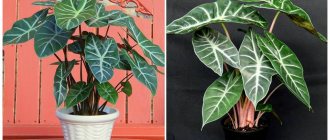Beauty who loves water
The Latin name for hydrangea, hydrangea, literally translates as “water vessel.” This name was not given to this plant in vain: hydrangea loves water very much and does not tolerate drought at all.
Hydrangea pleases with its beauty both in the room and in the garden
Hydrangea is a deciduous plant that sheds its leaves in the winter and goes dormant.
Main characteristics of hydrangea:
- there are about 80 species and a large number of varieties of hydrangea;
- types of hydrangeas are divided into liana-like, tree-like and shrubby;
- some species are frost-resistant;
- garden hydrangeas grow up to three meters in height, and liana-shaped ones even up to thirty;
- Hydrangeas live for about 20 years.
When grown at home, large-leaved hydrangea is used, which breeders use to create new hybrids and varieties of this spectacular plant.
Indoor hydrangeas can reach a size of up to 1.5 meters. New varieties for indoor cultivation usually have a height of 50 to 100 cm.
- Hydrangea leaves are jagged, ovoid with a sharp tip, 10–15 cm in length. They turn red in autumn and fall off by winter;
- inflorescences up to 35 cm in diameter, consisting of large sepals, which can be plain, of different colors or change as they develop and depending on the acidity of the soil;
- inside the sepals there are small petals;
- flowers can be sterile or fertile. The seeds are very small;
- the shape of flowers can be of four types: spherical, umbellate, pineal and racemose;
- sepals of different types and varieties have a variety of shapes and can be double;
- Hydrangea blooms from early summer to late autumn;
- The number of inflorescences on a hydrangea increases as the plant ages.
When grown at home, hydrangea is quite whimsical, but if you follow the rules of care, it will definitely delight you with its flowering.
The color range of hydrangeas is diverse, and the color of the flowers depends on the acidity of the soil. Because of this property, hydrangea is called a plant chameleon. There are varieties that do not change their color depending on the chemical composition of the soil.
Flower buds of ordinary large-leaved hydrangea are formed at the tips of last year's shoots, so pruning is done only on shrunken, excess shoots, without touching the tops with flower buds.
Now new varieties have been developed in which buds with future flowers are formed on the shoots of both last and this year. These are called remontants.
Hydrangea is a shade-tolerant plant. Moreover, its flowers do not tolerate bright sunlight.
Under natural conditions, hydrangea grows in Asia, America, China and Japan. Several species are native to Russia's Far East.
Hydrangea does not tolerate intense heat, so it is planted in the garden only in shady places. It requires high air humidity.
Hydrangea leaves can be used in tea. The roots, branches and inflorescences of paniculata and tree hydrangea are used for medicinal purposes and various medicinal preparations are made from them.
Lighting
At home, hydrangea prefers bright places, but protected from direct sunlight. It is advisable to place the crop 2–3 meters from the south window. If you grow a crop on a windowsill, then do not forget to shade it from direct sunlight, as it causes burns on delicate foliage. The eastern side of the room is also suitable, but in the west and north the plant will not take root. Or you will have to illuminate the flower with photo lamps, otherwise it will die.
Varieties of large-leaved hydrangea by flower color
There are a huge number of varieties of large-leaved hydrangea. Let's look at a few of the most popular ones, dividing them into color categories.
Light
Sister Therese (Soeur Therese):
- inflorescence diameter 30 cm;
- white inflorescences with a delicate lilac-pink tint change color to greenish-pink towards the end of flowering;
- blooms until September on last year's shoots;
- dense, spreading shrub.











